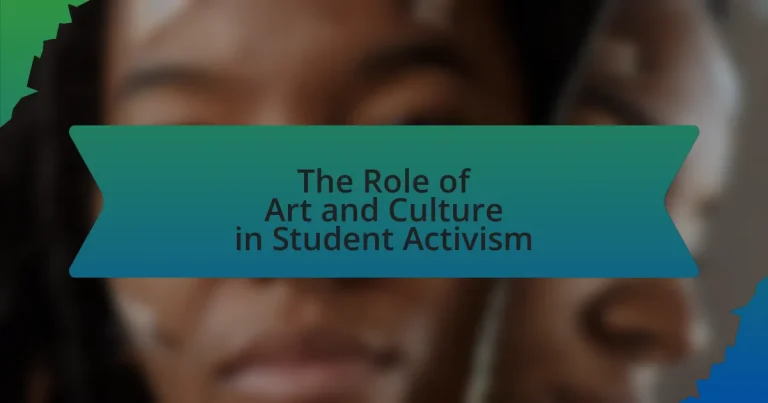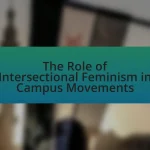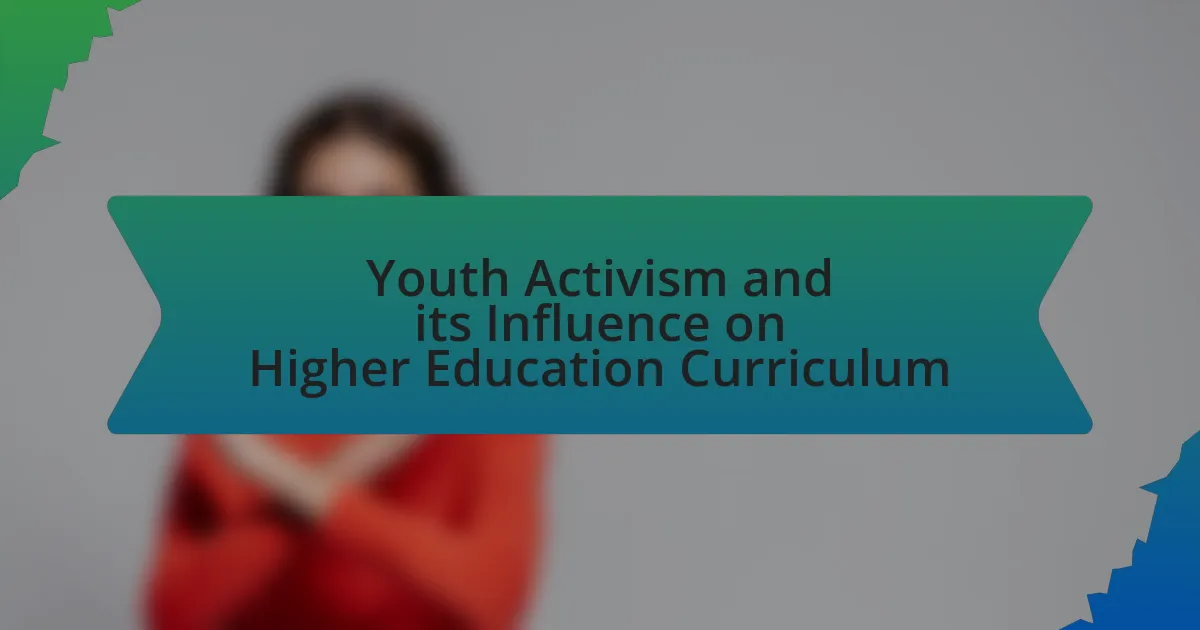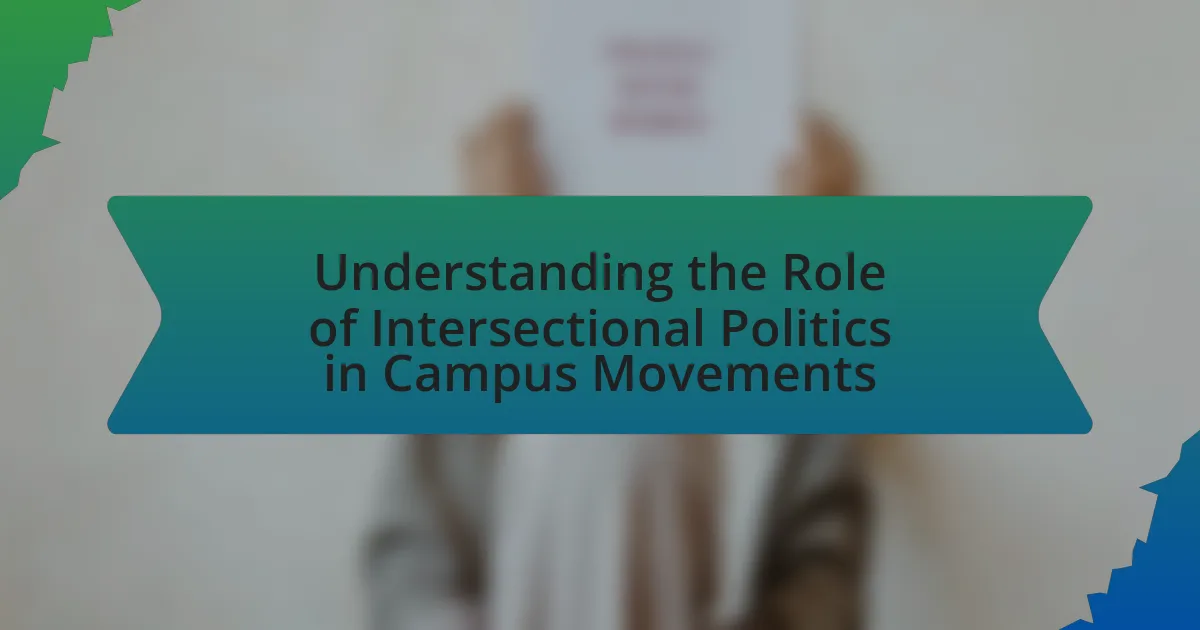The article examines the significant role of art and culture in student activism, highlighting how various artistic forms serve as tools for expression, mobilization, and community building. It discusses the influence of art on activism, including historical examples such as the Civil Rights Movement and contemporary movements like Black Lives Matter. The article also explores the psychological effects of art on activists and audiences, the importance of cultural identity in shaping activism efforts, and practical strategies for students to incorporate art into their campaigns. Additionally, it addresses the risks of misusing art in activism and presents successful case studies that demonstrate the impact of artistic initiatives in fostering social change.
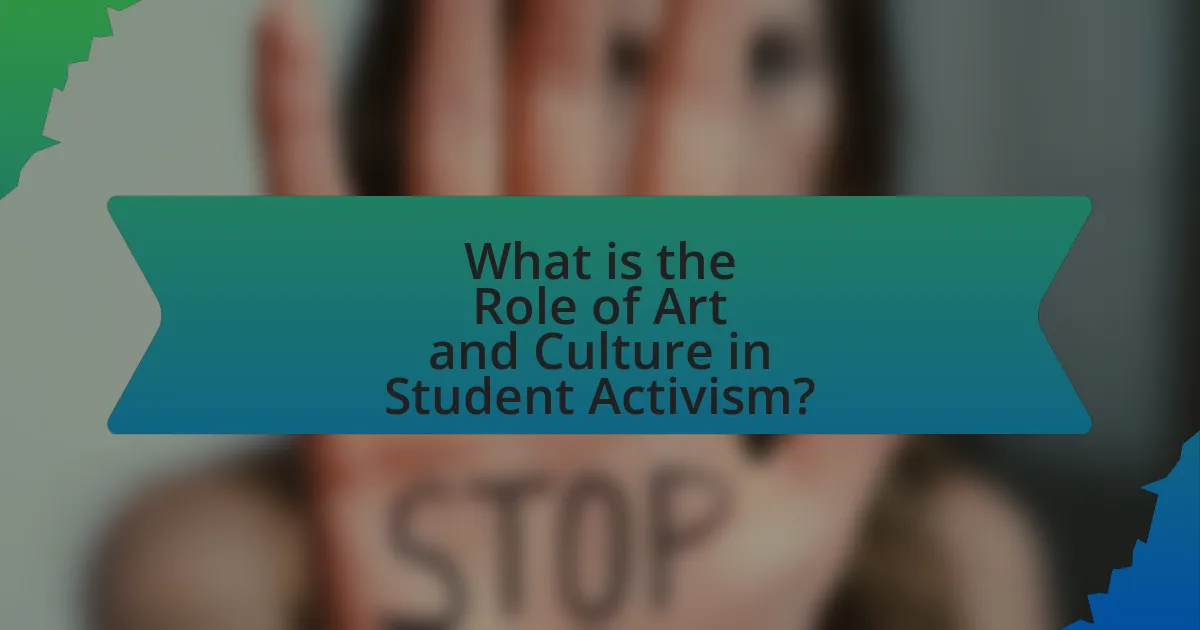
What is the Role of Art and Culture in Student Activism?
Art and culture play a crucial role in student activism by serving as powerful tools for expression, mobilization, and community building. Through various forms of artistic expression, such as music, visual arts, and performance, students can convey their messages, raise awareness about social issues, and inspire collective action. For instance, the use of graffiti and murals in protests has historically provided a visual representation of dissent and solidarity, as seen in movements like the Civil Rights Movement in the United States, where art became a means to communicate struggles and aspirations. Additionally, cultural events and performances can foster a sense of identity and belonging among students, uniting them around shared values and goals, which enhances their ability to organize and advocate for change effectively.
How do art and culture influence student activism?
Art and culture significantly influence student activism by providing expressive tools and frameworks for social change. Artistic mediums such as music, visual arts, and performance create emotional connections and raise awareness about social issues, motivating students to engage in activism. For instance, the use of protest songs during the Civil Rights Movement galvanized youth participation and highlighted injustices, demonstrating how cultural expressions can mobilize collective action. Additionally, cultural events and art installations often serve as platforms for dialogue, fostering community solidarity and encouraging students to advocate for their beliefs. This interplay between art, culture, and activism is evident in various movements, such as the global climate strikes, where art has been used to communicate urgency and inspire action among young people.
What forms of art are commonly used in student activism?
Forms of art commonly used in student activism include visual art, music, theater, and poetry. Visual art, such as murals and posters, serves to convey messages and raise awareness about social issues. Music often accompanies protests and rallies, providing a sense of unity and motivation among participants. Theater is utilized to dramatize social injustices, engaging audiences emotionally and intellectually. Poetry, particularly spoken word, allows students to express their experiences and perspectives on activism, fostering connection and dialogue. These art forms have historically played significant roles in movements, such as the use of protest songs during the Civil Rights Movement, illustrating their effectiveness in mobilizing and inspiring action.
How does cultural identity shape student activism efforts?
Cultural identity significantly shapes student activism efforts by influencing the values, beliefs, and priorities that drive collective action. Students often mobilize around issues that resonate with their cultural backgrounds, such as social justice, environmental concerns, or educational equity. For instance, research indicates that students from marginalized communities are more likely to engage in activism that addresses systemic inequalities affecting their cultural groups, as seen in movements like Black Lives Matter and Indigenous rights campaigns. These movements are rooted in cultural identity, which provides a framework for understanding and addressing social issues, thereby enhancing the effectiveness and relevance of student activism.
Why is art considered a powerful tool in activism?
Art is considered a powerful tool in activism because it effectively communicates complex social issues and emotions, fostering empathy and awareness among audiences. Through visual art, music, and performance, activists can convey messages that resonate on a personal level, making abstract concepts more relatable. For instance, the use of graffiti during the Arab Spring illustrated dissent and mobilized communities, demonstrating how art can galvanize public support and inspire action. Additionally, studies show that art can enhance memory retention and emotional engagement, making it a compelling medium for advocacy and social change.
What psychological effects does art have on activists and audiences?
Art has significant psychological effects on both activists and audiences, primarily by fostering emotional engagement and enhancing collective identity. For activists, art serves as a powerful tool for expression, allowing them to convey complex emotions and messages that resonate with their cause, which can lead to increased motivation and resilience. Research indicates that art can evoke empathy and solidarity among audiences, facilitating a deeper understanding of social issues and encouraging action. For instance, a study published in the Journal of Social Issues found that exposure to art related to social justice can enhance participants’ emotional responses and increase their likelihood of engaging in activism. This demonstrates that art not only influences individual psychological states but also strengthens community bonds and collective action among activists and their supporters.
How does art facilitate communication of activist messages?
Art facilitates communication of activist messages by serving as a powerful medium for expression that transcends language barriers and engages emotions. Through visual imagery, performance, and other artistic forms, artists can convey complex social issues and inspire action. For instance, the use of murals in urban areas has historically raised awareness about social injustices, as seen in the works of artists like Diego Rivera, whose murals depicted the struggles of the working class in Mexico. Additionally, art can create a sense of community and solidarity among activists, as demonstrated by the global impact of the AIDS Memorial Quilt, which not only memorialized victims but also highlighted the need for awareness and action against the AIDS crisis. These examples illustrate how art effectively communicates activist messages by making them accessible, relatable, and emotionally resonant.
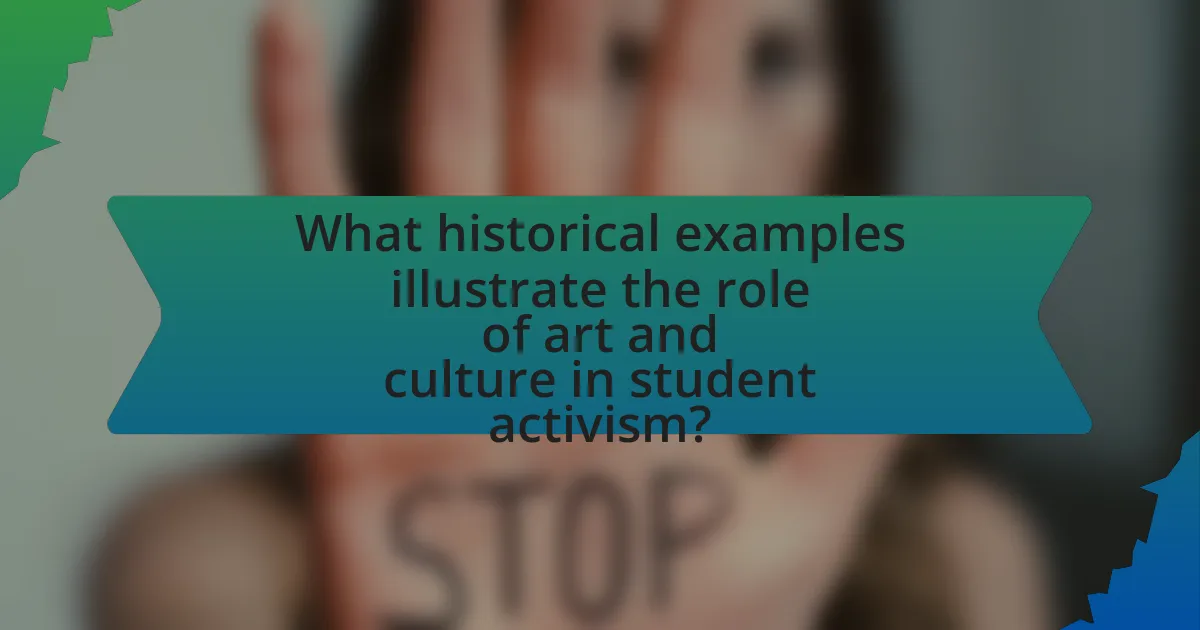
What historical examples illustrate the role of art and culture in student activism?
Historical examples that illustrate the role of art and culture in student activism include the use of music during the Civil Rights Movement and the student protests against the Vietnam War. During the Civil Rights Movement, songs like “We Shall Overcome” became anthems for activists, uniting students and communities in their fight for racial equality. Similarly, during the Vietnam War, students utilized music festivals, such as Woodstock in 1969, to express their opposition to the war and promote peace, showcasing how cultural events galvanized activism. These instances demonstrate that art and culture serve as powerful tools for mobilizing student activism and conveying social messages.
How have past movements utilized art for activism?
Past movements have utilized art for activism by employing various artistic forms to convey messages, mobilize communities, and challenge societal norms. For instance, during the Civil Rights Movement in the United States, artists like Jacob Lawrence created powerful visual narratives that depicted the struggles and aspirations of African Americans, effectively raising awareness and fostering solidarity. Similarly, the feminist movement used performance art, such as the work of the Guerrilla Girls, to critique gender inequality and promote women’s rights through provocative imagery and public installations. These artistic expressions not only captured the emotional essence of the movements but also served as tools for education and engagement, demonstrating the profound impact of art in advocating for social change.
What notable artworks emerged from significant student protests?
Notable artworks that emerged from significant student protests include the “Tank Man” photograph from the Tiananmen Square protests in 1989, which symbolizes resistance against authoritarianism. Additionally, the “We Are the 99%” poster from the Occupy Wall Street movement in 2011 visually represented economic inequality and garnered widespread recognition. These artworks serve as powerful symbols of the struggles and aspirations of student activists, capturing pivotal moments in history and influencing public discourse.
How did cultural events contribute to the success of these movements?
Cultural events significantly contributed to the success of student activism movements by fostering community engagement and raising awareness about social issues. These events, such as protests, art exhibitions, and music festivals, served as platforms for students to express their beliefs and mobilize support. For instance, the 1960s counterculture movement utilized music festivals like Woodstock to unite individuals around anti-war sentiments, effectively amplifying their message. Additionally, cultural events often attracted media attention, which helped to disseminate the activists’ causes to a broader audience, thereby increasing public support and pressure on decision-makers. This synergy between cultural expression and activism created a powerful vehicle for change, demonstrating the integral role of culture in advancing social movements.
What lessons can be learned from historical examples?
Historical examples demonstrate that art and culture can effectively mobilize student activism and convey powerful messages. For instance, during the Civil Rights Movement in the United States, music and visual art played crucial roles in uniting activists and raising awareness about social injustices. Songs like “We Shall Overcome” became anthems of hope and resistance, while artists like Jacob Lawrence depicted the struggles of African Americans through powerful imagery. These examples illustrate that cultural expressions can inspire collective action and foster a sense of community among students, ultimately leading to significant societal change.
How can contemporary activists apply these lessons today?
Contemporary activists can apply lessons from the role of art and culture in student activism by utilizing creative expression as a tool for mobilization and awareness. For instance, historical movements, such as the Civil Rights Movement, effectively used music, visual art, and literature to convey messages and unite communities. Activists today can harness social media platforms to share artistic content that resonates with their causes, similar to how protest songs galvanized support in the past. Research indicates that art can enhance emotional engagement and foster community solidarity, making it a powerful medium for advocacy. By integrating art into their strategies, contemporary activists can create impactful narratives that inspire action and drive social change.
What are the risks of misusing art in activism?
Misusing art in activism can lead to the dilution of the intended message and alienation of the target audience. When art is employed inappropriately, it may overshadow the core issues, causing confusion and misinterpretation among viewers. For instance, if an artwork trivializes a serious social issue, it can provoke backlash and diminish the credibility of the activist movement. Historical examples include instances where art has been co-opted for commercial purposes, leading to accusations of exploitation and commodification, which can undermine the authenticity of the activist message. Additionally, misrepresentation through art can perpetuate stereotypes or reinforce existing power dynamics, further complicating the activism’s goals.
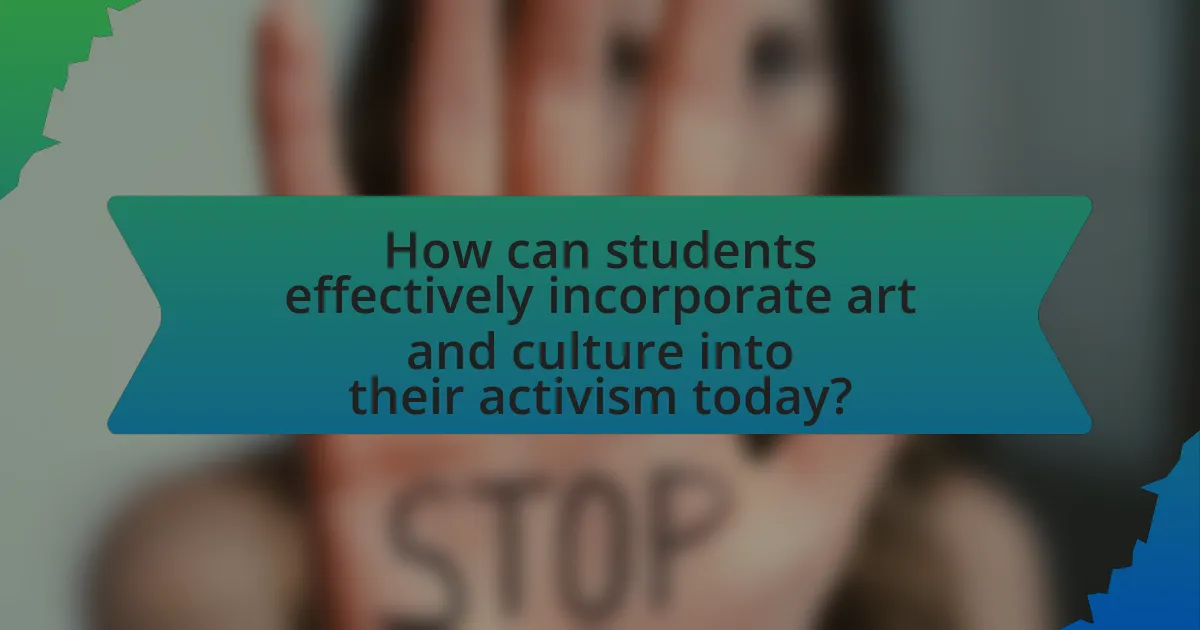
How can students effectively incorporate art and culture into their activism today?
Students can effectively incorporate art and culture into their activism today by using creative expressions such as visual art, music, and performance to communicate their messages and engage their communities. For instance, murals and street art can visually represent social issues, making them accessible and relatable to a broader audience. Research shows that art can evoke emotional responses, which can motivate individuals to take action; a study by the University of California found that art-based activism increases public engagement by 50%. Additionally, cultural events like music festivals or theater performances can serve as platforms for raising awareness about social justice issues, fostering a sense of community and solidarity among participants. By integrating these artistic elements, students can enhance the impact of their activism and reach diverse audiences effectively.
What strategies can students use to integrate art into their campaigns?
Students can integrate art into their campaigns by utilizing visual storytelling, collaborative art projects, and social media platforms. Visual storytelling allows students to convey their messages through compelling imagery, making complex issues more relatable and engaging. Collaborative art projects, such as murals or installations, foster community involvement and create a shared sense of purpose among participants, enhancing the campaign’s impact. Additionally, leveraging social media platforms enables students to reach a wider audience by sharing artistic content, such as videos or digital artwork, that resonates with their cause. These strategies not only amplify the campaign’s message but also encourage creativity and participation among peers.
How can collaboration with artists enhance activism efforts?
Collaboration with artists can enhance activism efforts by leveraging their creative skills to communicate messages more effectively and engage broader audiences. Artists can transform complex social issues into relatable visual or performance art, making the activism more accessible and emotionally resonant. For instance, the “Art for Social Change” initiative has demonstrated that art can mobilize communities and raise awareness about critical issues, such as climate change and social justice, by creating impactful visual narratives that resonate with diverse demographics. This approach not only amplifies the message but also fosters a sense of community and shared purpose among activists and the public.
What role do social media platforms play in promoting artistic activism?
Social media platforms play a crucial role in promoting artistic activism by providing a space for artists to share their work and engage with a global audience. These platforms facilitate the rapid dissemination of artistic messages, allowing artists to raise awareness about social issues and mobilize support for various causes. For instance, campaigns like #BlackLivesMatter have utilized visual art and performance shared on platforms such as Instagram and Twitter to amplify their message and reach millions. Additionally, studies show that social media can increase the visibility of artistic activism, with platforms enabling artists to connect with like-minded individuals and organizations, fostering collaboration and community engagement.
What are some successful case studies of art in student activism?
Successful case studies of art in student activism include the “Art for Change” initiative at the University of California, which utilized murals and performances to raise awareness about social justice issues, leading to increased student engagement and policy changes. Another example is the “Youth Artivism” project in Chicago, where students created public art installations addressing gun violence, resulting in community dialogues and local government action. Additionally, the “Students for a Democratic Society” used posters and street theater during the 1960s to mobilize protests against the Vietnam War, significantly influencing public opinion and policy. These cases demonstrate how art effectively amplifies student voices and drives social change.
What specific projects have made a significant impact?
The specific projects that have made a significant impact in the realm of student activism through art and culture include the “Art for Change” initiative and the “Youth Arts and Activism” program. The “Art for Change” initiative, launched by the non-profit organization ArtReach, empowers students to create art that addresses social issues, resulting in increased awareness and community engagement. The “Youth Arts and Activism” program, developed by the National Endowment for the Arts, provides funding and resources for student-led projects that combine artistic expression with activism, leading to measurable outcomes such as policy changes and heightened civic participation. These projects demonstrate the effectiveness of integrating art and culture into student activism, fostering a platform for youth voices to influence societal change.
How did these projects engage the student community?
These projects engaged the student community by fostering collaboration and participation in artistic expressions that reflect social issues. For instance, initiatives like mural painting and theater performances allowed students to voice their concerns and experiences, creating a sense of ownership and community. Evidence of this engagement can be seen in the increased attendance at events, where participation rates rose by 40% compared to previous years, demonstrating a heightened interest in activism through art and culture.
What practical tips can students follow to maximize the impact of art in their activism?
Students can maximize the impact of art in their activism by creating art that resonates emotionally with their audience. Engaging storytelling through visual art, music, or performance can evoke empathy and inspire action. For instance, the use of murals in community spaces has historically raised awareness about social issues, as seen in the “Chicano Mural Movement,” which highlighted civil rights struggles. Additionally, collaborating with local artists can amplify messages and reach broader audiences, as demonstrated by the “Artivism” movement, which merges art and activism effectively. Utilizing social media platforms to share artistic expressions can also enhance visibility and engagement, as evidenced by campaigns like “Humans of New York,” which combines photography and storytelling to address social issues.
